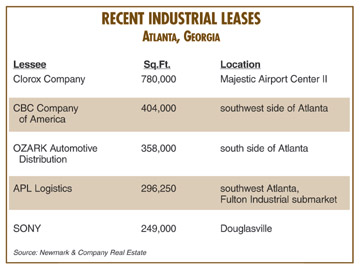|
SOUTHEAST SNAPSHOT, OCTOBER 2004
Atlanta Industrial Market
 |
|
Michael Demperio
Principal – Industrial Properties
Newmark & Company Real Estate
|
|
Due to the limited new construction during the past 4 years
in the Atlanta market, there has been no significant change
to the physical attributes of both the bulk industrial and
office warehouse structures, according to Michael Demperio,
principal – industrial properties with Newmark &
Company Real Estate’s Atlanta office.
Geographically, any future development will be occurring farther
from the center of Atlanta, as land availability is scarce.
“Thus, land values have increased substantially both
near the perimeter highway, Interstate 285 and in outlying
areas,” Demperio says. “Additionally, much of the
land that is geographically acceptable has been passed over
during the last expansion period and has engineering challenges.”
There are few new industrial developments that have been announced
in the past 12 months in Atlanta due to the recent real estate
recession. However, the large industrial parks that were developed
during the past 3 years still have land availability, and
these parks will attract a significant amount of build-to-suit
and speculative buildings within the next 3 years.
New tracts of bulk industrial land located within Atlanta
are priced at $70,000 to $125,000 per acre, which may make
industrial development cost-prohibitive.
“Therefore, Braselton, in northeast Atlanta near the
Mall of Georgia on Interstate 85, may experience future development,”
says Demperio.
Bulk warehouse rental rates are averaging between $2.35 and
$2.55 per square foot with 3 percent office, and office/warehouse
rates with a 20 percent finish are averaging $4.50 to $5 per
square foot.
The south side of Atlanta is still an attractive alternative
with numerous tracts of affordable developable land. “Nevertheless,
at this time, there are limited new proposed projects due
to the competitive leasing climate,” Demperio says. “New
construction will not be feasible until the vacancy rate drops
and the rental rate rises substantially.”
In the near future, the corridors of Interstate 20 west, Interstate
75 south and Interstate 85 south should continue to be areas
of interest due to the excellent labor source, a large availability
of land and excellent accessibility. At the current time,
however, the majority of the industrial real estate development
is taking place south of Interstate 20 and Hartsfield-Jackson
International Airport. “The main reason for the development
in this area is the lack of available land in northwest and
northeast Atlanta, coupled with lower land prices,” he
says. “Labor is cheaper and the area provides better
accessibility to the interstates and to the airport/airfreight.”
Catellus recently has made a major entry into the Atlanta
market by developing a 900,000-square-foot building for APL
Logistics. Cousins Properties also has announced its intention
to develop industrial properties, and it currently has at
least one property under contract and others in review. “These
developers are paying more for land to get entry into the
Atlanta industrial market and only time will tell if they
can hit their proforma numbers,” Demperio says.
“Most of the bulk developments are attracting large national
and international companies that have very simple distribution
needs, such as high clear ceilings, trailer storage and access
to the interstate,” he says.
Atlanta’s vacancy has recently decreased to 14.4 percent,
which includes all industrial space. Atlanta had a positive
net absorption in the first quarter of 2004, and the second
quarter resulted in almost 3 million square feet. Unfortunately,
the vacancy rate is still too high for rent appreciation.
The south side of town has numerous large bulk industrial
blocks available: Catellus has 450,000 square feet; Opus has
500,000 square feet; Duke has 500,000 square feet; Carter
has 500,000 square feet; and Panattoni has 450,000 square
feet.
“Atlanta is still a tenants’ market,” says
Demperio. “And if the next 2 years provide positive net
absorption as seen historically — 10 million to 12 million
square feet per year — we should see rent growth and
additional industrial developments.”

©2004 France Publications, Inc. Duplication
or reproduction of this article not permitted without authorization
from France Publications, Inc. For information on reprints
of this article contact Barbara
Sherer at (630) 554-6054.
|
